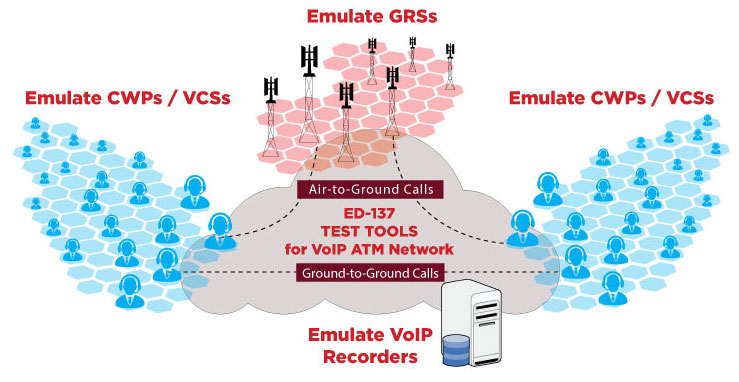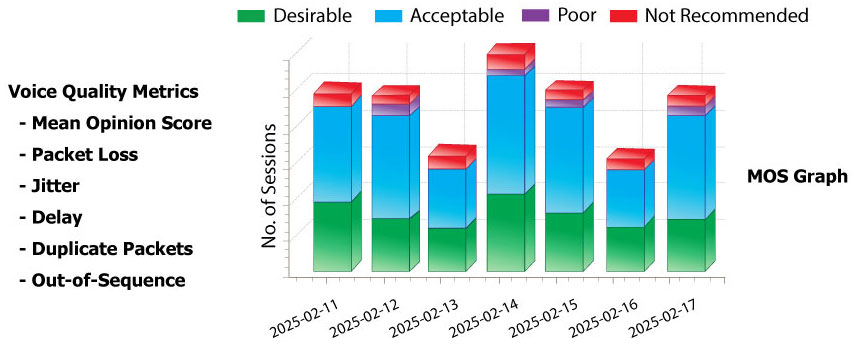Comprehensive ED-137 Solutions for Air Traffic Communication Testing
Welcome to GL's Latest Newsletter! In this edition, we showcase our ED-137 testing solutions for Air Traffic Management (ATM) networks. Our solutions are fully compliant with EUROCAE ED-137 standards, ensuring robust and versatile testing capabilities across a wide range of air traffic applications, including air-to-ground and ground-to-ground communications.

Overview
GL provides advanced testing solutions for next-generation ATM networks, enabling precise emulation and load testing of Controller Working Positions (CWPs), Ground Radio Stations (GRSs), Analog-to-IP converters, and Gateways. These tools evaluate performance, functionality, and timing accuracy. Fully compliant with EUROCAE ED-137 standards, GL’s solutions support signaling and traffic emulation for air-to-ground and ground-to-ground interfaces. For service quality monitoring per ED-138, they offer detailed voice metrics such as Mean Opinion Score (MOS), packet loss, jitter, and latency, along with support for PESQ and POLQA voice quality scoring.
Fully compliant with the latest ED-137 standards, our solution ensures seamless interoperability and supports rapid adaptation to new revisions and future updates. GL actively engages in industry conferences and working groups to stay aligned with evolving specifications and offers full IPv6 support to meet the requirements of modern IP-based communications infrastructure.
Trusted globally by Air Navigation Service Providers and manufacturers of Voice Communication Systems (VCS), radios, recorders, and gateways, GL’s ED-137 and ED-138 VoIP Test Tools are used for development, functional verification, load testing, factory acceptance, deployment, and field testing. The test suite includes timing measurement tools for accurate signal and voice delay analysis.
GL’s Message Automation and Protocol Simulation (MAPS™) framework supports protocol emulation across Analog, TDM and VoIP technologies. It emulates ED-137-compliant Radio, Telephone, and Recorder interfaces for testing VoIP-based ATM systems. MAPS™ runs on the Windows® operating system and uses the PC’s network interface card to send and receive traffic.
ED-137 Interface Emulation for Air Traffic Systems
MAPS™ ED-137 Radio emulates air-to-ground communication by emulating either CWPs or Radios, in accordance with ED-137 Volume 1 – Radio specifications. The Radio emulator emulates up to 500 concurrent radios, each configurable for IP address, codec (G.711 A-law/µ-law, G.729), call behavior, and priority. It supports PTT sessions (normal, emergency, priority override) and multicast operation for efficient broadcast stream handling. Features include Selective Calling (SELCAL) for targeted aircraft communication, real-time audio generation (voice files, DTMF, tones), and support for Receiver Muting Management (RMM) and Media Activation Management (MAM) messaging to analyze delay, jitter, and media path activation.
Similarly, MAPS™ ED-137 Telephone emulates ground-to-ground SIP-based telephony between CWPs and ground stations per ED-137 Volume 2 (2B/2C). It supports key ATC call types such as Instantaneous Access, Direct/Indirect Access, and General Purpose with priority handling. The Telephone emulator offers advanced features like call hold, transfer, conferencing, and call pickup, and generates hundreds of simultaneous SIP calls with customizable voice traffic (DTMF, tones, noise, voice files). It supports IPv4/IPv6, IP spoofing, TCP/UDP, dynamic session control, and FAA-specific addendums for legacy, override, and voice call handling.
Optionally, the MAPS™ ED-137 Telephone Emulator supports the following addendums:
- Addendum 2: FAA Legacy Telephone Interworking
- Addendum 4: Override Call
- Addendum 5: Voice Call
MAPS™ ED-137 Recorder emulates the recording interface at the CWP, GRS, and Recorder Server, in compliance with ED-137 Volume 4 – Recorder. A single instance/license can emulate hundreds of CWPs or Radios and can generate bulk air-to-ground or ground-to-ground calls for load and performance testing.
All our emulators support both ED-137 B and C versions and are enhanced to support ED-137C Change 1 and Change 2, as well as IPv6. The emulators have been validated using EUROCAE’s VOTER tool, ensuring compliance and reliability. These solutions can be used for both functional and load testing of interfaces such as CWP, VCS, GRS, Recorder, and Radio Gateway.
The MAPS™ framework also allows customization, enabling users to edit protocol messages and build custom or negative test scenarios. Additionally, the emulators support IP impairment emulation, including packet loss, duplication, out-of-sequence delivery, and latency, to help verify performance under adverse network conditions. All traffic can be monitored using the GL’s PacketScan™ protocol analyzer and analyzed either locally or remotely using web-based NetSurveyorWeb™ applications.

Centralized Monitoring for ED-138 Air-Ground and Ground-Ground Calls
Measuring voice quality, latency, packet loss, and other metrics across air traffic networks is essential for ensuring safe and reliable aviation communication. GL’s PacketScan™ software offers powerful features to capture and monitor live signaling and voice traffic. It supports the capture, decoding, segregation, monitoring, and statistical analysis of both ground-to-ground and air-to-ground calls in compliance with EUROCAE ED-138 standards.
PacketScan™ is a protocol analysis tool for passive monitoring and troubleshooting. It measures voice quality parameters such as MOS, packet loss, jitter, delay, and more on captured calls. Multiple PacketScan™ probes can be deployed across the network, each sending call detail records to a centralized database, which can be accessed and queried via web browsers.
GL’s NetSurveyorWeb™ is a web-based, centralized network surveillance system with a back-end database. It displays call detail records, measurement results, and network performance metrics. It provides both real-time and historical analysis through graphical reports, alarms, filters, search capabilities, and email notifications. The platform supports multi-user access with user authentication, making it ideal for collaborative network monitoring.

End-to-End Delay and Voice Quality Measurement for Air Traffic Systems
Accurate event timing is critical for ANSPs and equipment manufacturers to assess device and network performance. GL’s Timing Measurement in Air Traffic Management (TM-ATM) solution enables precise delay and voice quality measurements across analog, TDM and IP interfaces. It combines hardware and software to emulate, capture, time stamp, filter, and correlate key events.
The solution includes multiple modules:
- Central Administrative System (MAPS™ Administrator): Centralized control application that manages and logs test activities
- Packet Analyzer: Features a powerful Wirespeed filter to detect IP events (e.g., PTT On/Off, Squelch On/Off), with GPS-based time stamping. Filters can also be mapped to 12 TTL outputs on the device for external signal monitoring or triggering
- Audio Analyzer: Injects and records analog audio for delay and voice quality analysis using ITU-T PESQ and POLQA standards
- Discrete Signal Logger: Emulates and detects control signals such as PTT, Tx/Rx transfer, and mute/unmute functions
GL’s solution measures delays for various events, including PTT actions, confirmation signals, Squelch activity, Main/Standby transfers, and voice path delays. It supports both rack-mounted (lab) and portable (field) hardware, using GPS-based timing for high accuracy during deployment and testing. Automated testing with repeatable iterations ensures consistency and precision.
 Back to Newsletter Index Page
Back to Newsletter Index Page